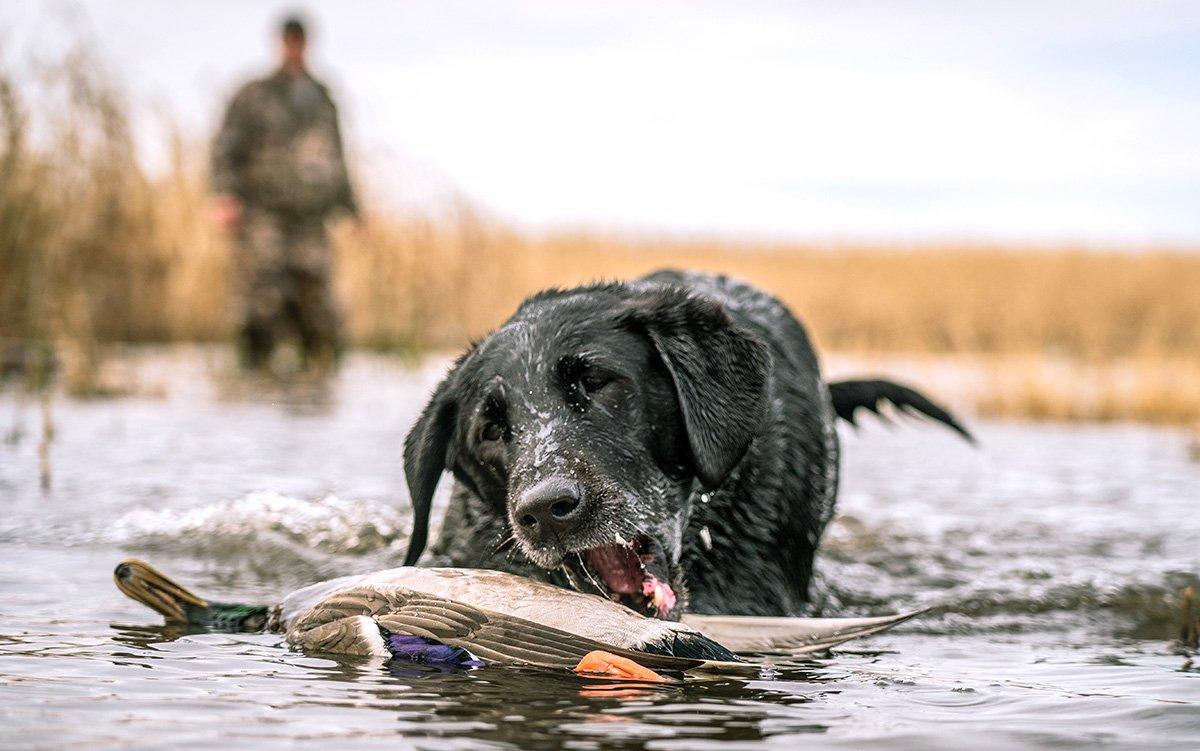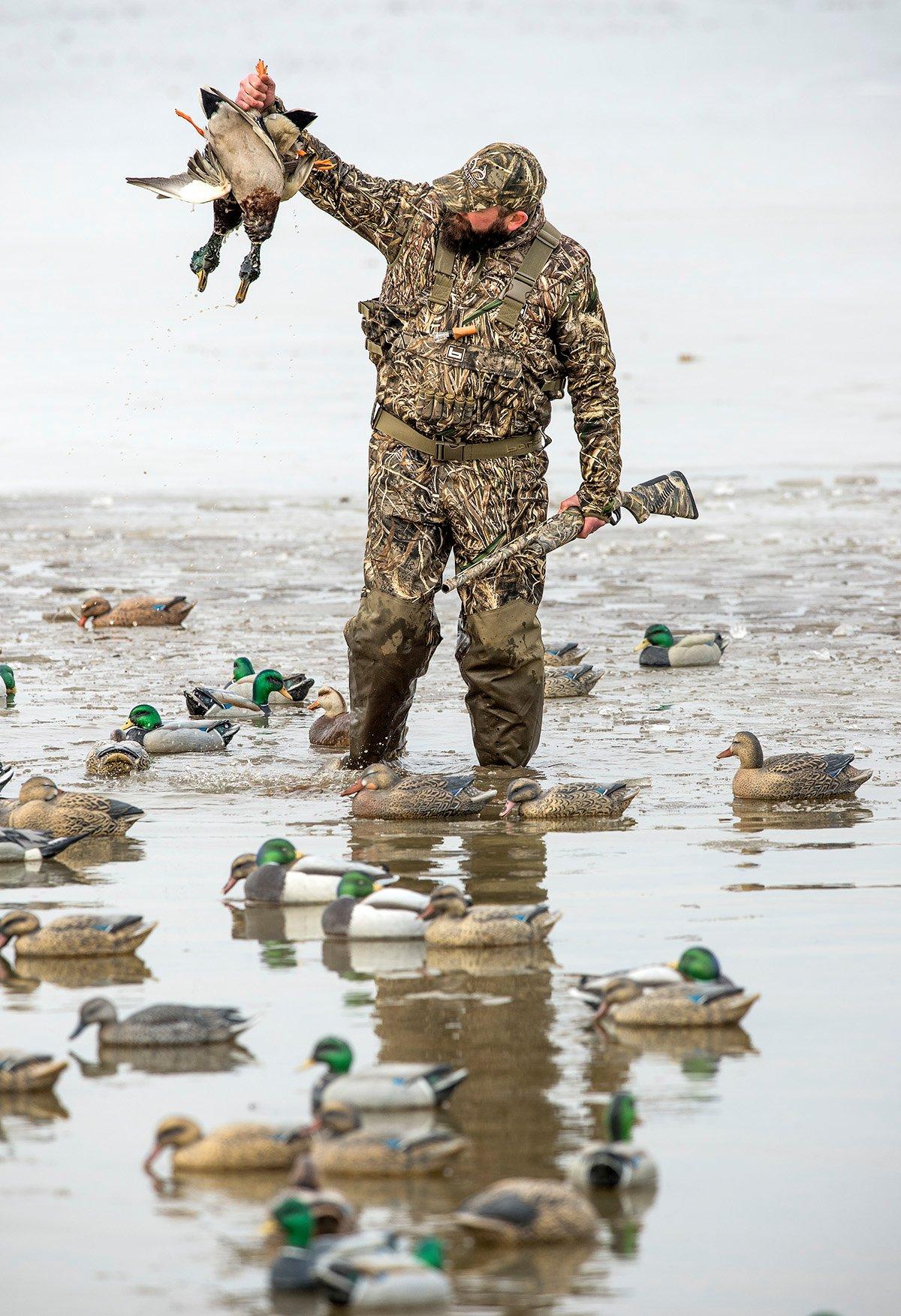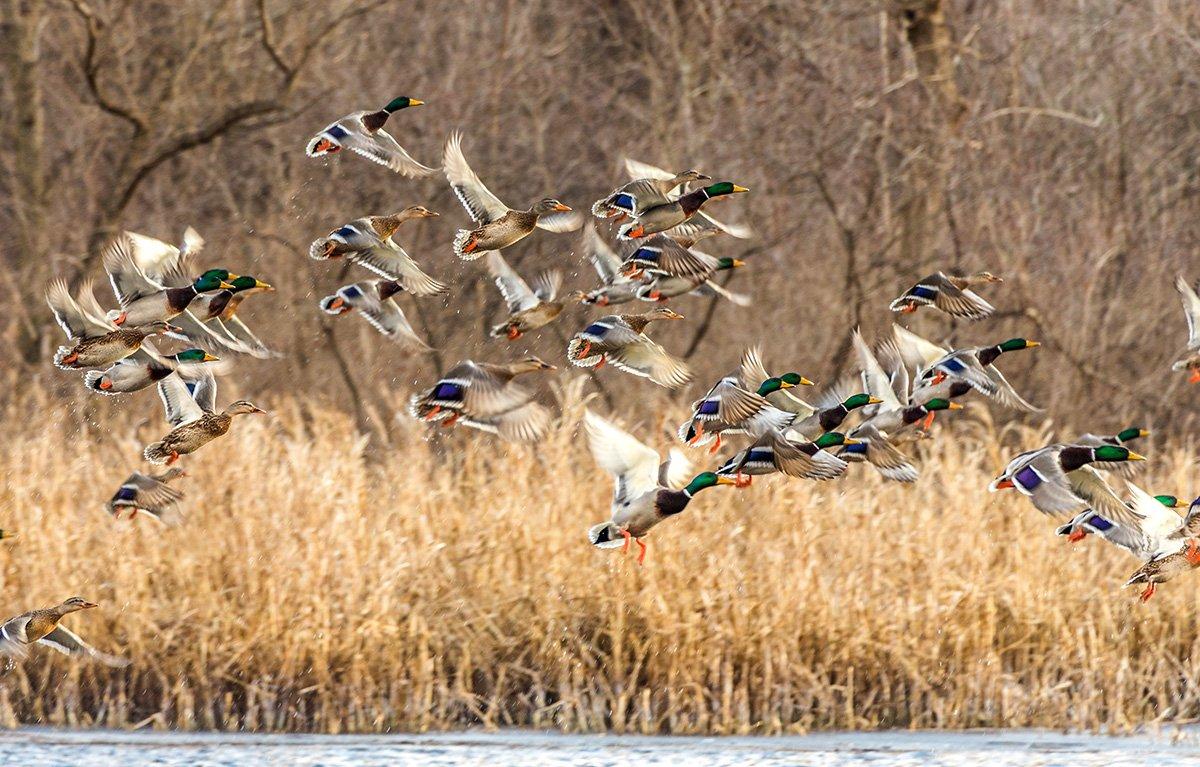Want to shoot more greenheads? Check out this expert advice for America's No. 1 duck
Mallards captivate and mystify hunters across the country, and filling straps with plump greenheads remains one of waterfowling's top achievements.
That's partly because wary, unpredictable mallards can be tough to hunt. If you want to bag more greenheads this year, try these tips.
1) Like many ducks, mallards love fresh water. When heavy rains flood fields or force rivers over their banks, search for new temporary water in fields, pastures or riparian areas. Mallards will find and use those spots immediately.
2) In ag fields, keep your mallard decoys upwind of honker decoys. Geese are often very aggressive in feeding situations, and mallards try to stay ahead of them when sharing a field.
3) When hunting dry fields, use spinners with remote on/off switches. Many days, mallards finish better when you turn off the spinners as birds approach to within about 60 yards.
4) In the North, take immediate advantage of freeze-up situations that concentrate mallards in springs, creeks or other small open water. You'll often get one good hunt out of such spots, so make hay the first hour or two.
5) Always put your decoys in the ripples and in the sunshine, says Brandon Martin, creative director for Banded and founder of DayBreak Outdoors. This gives ducks the illusion of the decoys being real. It gives ducks more confidence committing. If you leave decoys in glassy water, ducks know something is up. It's the same with decoys in the shadows. It gives ducks a doubt in their minds, and they end up not coming into your decoy spread more times than not.
6) In green timber, mallards cannot usually see down through the canopy of trees, so they locate one another via sound. As such, calling becomes extremely important. Strive to call as realistically as possible. In many areas, you'll be competing with the country's best duck callers.
7) I want to make sure I'm as concealed as possible, says Jeremy Dersham, owner of Ridge and River Running Outfitters, who guides hunters on Pool 9 of the Mississippi River in southwestern Wisconsin. I'm trying to have the sun at my back, a crosswind if possible and a loud call if needed.
8) In many areas, hunters try to identify early-season eclipse-plumage drake mallards by their chestnut breasts. Be careful, though, as some feathered-out hens also have chests that are darker than their bellies. If you're unsure, wait till sunrise.
When it comes to working mallards, it ain't how good you know how to call, it's how good you know when to call. — Billy Campbell
9) When it comes to working mallards, it ain't how good you know how to call, it's how good you know when to call, says Billy Campbell, co-host of Black Cloud on Realtree 365.
Learn to read ducks. Use hail or greeting calls when trying to get their attention at a distance or if they're leaving. If mallards approach your spread, use soft quacks or feeding chuckles, or stay silent. If a flock circles but seems to be leaving, use a hail or come-back call. If ducks turn back, go soft and subtle again.
10) Dersham says hunters should adjust their setups when mallards don't commit. It's easy to get frustrated and lose sight of a glaring piece of the boat or birds overshooting your spread because of the way your decoys are set up with the wind. Adjust, flare birds in the short time, and see how others work your spread.
11) You can do well on mallards during big-water combo hunts for divers and puddlers. In most situations, set some mallard blocks apart and upwind from the divers. Throwing in some honker blocks doesn't hurt. Divers and puddlers mix to feed on occasion, although the playbook says they won't. Pool 9 of the Mississippi River, where mallards and other puddlers mix heavily with canvasbacks to gorge on wild celery, is a prime example. If you see that happening, mix mallards with divers, but leave good open holes where flocks feel comfortable decoying.
12) You've got to find 'em to shoot 'em, Campbell says. Scouting is No. 1 on the list. If you watch Black Cloud on Realtree 365, you know Campbell and co-host Dennis Dr. Duck Loosier put in tremendous work — often on foot to avoid spooking birds — to locate unpressured ducks. Sometimes, they'll scout several days to identify one good opportunity.
13) When hunting small potholes or sloughs, leave an ample landing area (kill hole) within easy gunning distance, but don't place your hide or boat directly upwind of it. Offset it a bit so mallards won't be looking right at you when decoying into a stiff wind.
14) Also for sloughs or potholes, don't worry so much about spread configuration. Rather, fill holes. That is, place a few decoys at ancillary areas where finicky mallards might land instead of the kill hole. Make your kill hole their best landing option.
15) Always look for the next hot field. Late-season mallards especially love fresh combined corn, assuming the combines leave enough waste grain. However, when corn is in short supply, they'll also hit beans, peas, barley or winter wheat. Note crop and harvest situations as you scout, and always be on the lookout for a potential hotspot.
16) Justin Martin, general manager of Duck Commander, prefers a realistic low-key approach for late-season Southern mallards. If I find a spot that I believe is holding 40 birds — which is all you need for a good four-man shoot, provided they don't all show up at once — I will use 12 to 18 decoys to create the scenario that some of their friends are already there, but not everyone, he says.
17) When finishing large flocks, avoid temptation to kill the bird that inevitably commits more wholeheartedly than the rest. Instead, start at the back of the flock, taking birds that are still in good range but that could escape more quickly if you miss. Then work your way toward the front, picking off closer birds.
18) On big water, identify what areas mallards are using, and determine when and why they like those spots. Often, they use much smaller portions of big waters to feed, find shelter from wind or even roost some nights. Finding those spots lets you eliminate lots of unproductive water.
19) Motion in your spread is important, especially when you're trying to get mallards to finish in timber. Some folks use jerk strings or pulsating decoys to give the impression of birds swimming or feeding. Many kick or churn the water with their legs to provide the same effect.
20) I always scout with my ears more than my eyes, Justin Martin says. Down here, if you bump the birds, the chances of them coming back are slim. I have a general rule: If I hear one hen, that generally equals 10 ducks that are there. The more hens you hear, the more ducks there are, for obvious reasons. If you are scouting and flush birds that were being quiet, they aren't 'happy' ducks. They are hiding out from hunters or from other ducks the later in the season you go. They begin to get more and more reclusive once their biological clocks get ticking.
21) Pressured mallards often roost on large bodies of water but spend much of the day loafing at small, hidden spots, including creeks, ditches and small rivers. Jump-shooting these places — especially those near refuges or large wildlife areas — can be productive. Winding creeks and streamside vegetation let you slip unseen around bends and backwater sloughs where ducks congregate.
22) Don't believe the myth about cloudy, rainy days being best for mallards. Experienced hunters love sunny conditions with moderate to strong winds. Sun creates shadows, which help you hide better. Also, it makes your decoys more visible and helps you identify drakes as they approach.
23) Realtree.com contributor James Buice scours public water for areas other hunters overlook.
In really heavily hunted areas, I'll start looking for heavy cover — areas that are not as obvious for other hunters, he says. Mallards will drop down into tiny holes in the canopy and filter into these thickets to feed when heavily pressured. Google Earth won't help here, as the holes in the canopy are usually too small to see. You have to burn a morning, watch ducks, and try to follow them. Wait until people start shooting and see where the birds go after they're shot at. These sanctuary holes are great a few hours after shooting light.
24) Justin Martin keeps his mallard calling practice simple yet practical. I set my sights to sound as close to a mallard hen as possible, he says. I didn't practice to do anything fancy. I just wanted to be a mallard hen. I would go to the refuges and sit at the sanctuaries and carry on conversations with wild ducks. Once they came looking for me, I knew I had to be onto something.
25) Hunt mallards from 1 to 3 p.m.? Absolutely, according to a Realtree.com article by contributor Joe Genzel. In the piece, Chad Belding, host of The Fowl Life, explains why: Some hunters just don't understand that when the weather gets this cold, greenheads are going to come off that morning and evening flight pattern. What's going to happen is those birds are grouping up with their heads down to keep a pocket of water open, conserving energy, waiting for the sun to melt off some of that ice so they can get to the feed. Mallards will sit there and only fly off the refuge once to eat, typically during the warmest part of the day.
26) When it warms up (in Louisiana), the mallards don't necessarily leave, they change their diet, Justin Martin says. When it is cold, they prefer to eat carbs, which is where the grain fields come into play. When it warms up, check moist-soil areas. The ducks then go for calcium-rich items, which are invertebrates. Hens are beginning to stock up for egg production, and they need all the calcium they can get. Where the girls go, the boys surely follow.
27) J.D. Driskill, owner of Dirty Rice Outfitters near Gobler, Missouri, says much of his mallard calling routine comes from muscle memory, so he focuses on another element: the ability to control air. It takes a lot of air to blow a call every day and not get winded," he says. I exercise by fogging a window. That's just taking really deep breaths — as deep as you can get them — and then just standing in front of a mirror or windowpane and fogging the window with your breath. That's really how you blow a call is from the bottom up. You just learn to control it with your throat and your air.
28) Concealment is critical any time you hunt mallards, but many timber hunters get sloppy. Because they're standing by big trees, they feel like they're hidden, but they're not, Loosier says. Get behind the tree, or hug up to the tree. Don't stand 2 to 3 feet away from it. When birds are working, you want to be a part of that tree. I tell guys if the duck had a gun, where would you be? You'd be tucked up behind that tree, hiding real tight.
29) Kent Woodrow, co-owner of Illinois Whitetail & Waterfowl, says weather and other environmental factors greatly influence whether mallard hunting will be better in timber or impoundments. If ducks are feeding at night, timber is probably better during daylight, he says. They'll go in there and loaf and hang out.
Conversely, frigid temperatures or approaching fronts often prompt birds to feed in flooded crop fields during daylight, making impoundments the likely choice, he says. When it starts turning cold, they want to be in the food all the time.
30) Working birds into a timber hole can provide in-your-face shooting, but Belding says the moment of truth will look much different than with open-water hunting.
Once they get down into those woods and under those treetops, they'll start to bounce, he says. Some will go to the left and some to the right, trying to pick out where to land. Some might try to land at your feet. You don't just have a set visual in front of you. Everything is different, as there are trees everywhere. Calling the shot in flooded timber becomes a talent and an instinct you have to master and not make any mistakes. I think a lot of shots get called too early because of the excitement level of seeing those ducks get below the trees. Just because they break those trees doesn't mean they're killable. If you let them be wild and let them hunt you, you'll get much better shots.
Click here for more Realtree waterfowl hunting content. And check us out on Facebook.











